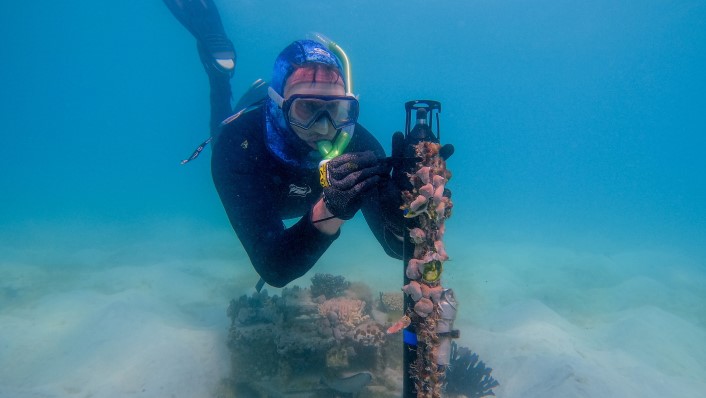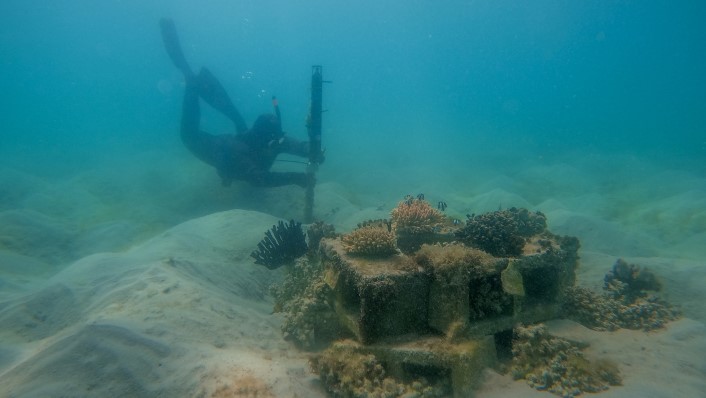We know that noisy reefs are healthy, but carefully listening to the sounds made by fish, invertebrates and humans underwater can help us understand the details better, such as changing diversity, distribution and abundance of species. There might even be new species to identify in the cacophony.
AIMS scientists and collaborators have been refining techniques to help them hear these details more clearly.
In a series of papers, AIMS researchers and partners have found that coral reef soundscapes vary significantly across reef habitats and can reflect subtle differences in biological communities.
They also tested different analytical tools and methods for recording and analysing underwater sound that will help scientists discriminate between different sounds, and improve the design of monitoring systems.
Senior co-author on the papers, AIMS acoustic scientist Dr Miles Parsons, said: "Coral reefs are vital ecosystems supporting livelihoods, biodiversity, industries like tourism and fisheries and providing coastal protection. To assist them under a changing climate, we need to understand them, and monitoring their noises can help.
"We know that acoustic monitoring offers complimentary and scalable tools for monitoring reef health. In some cases, it's the most feasible method of data collection because it's autonomous and long term.
"It also captures information on parts of the underwater community that are otherwise difficult to sample, such as cryptic species that make specific noises, and records behaviours at times and in conditions when it's difficult to sample, such as deep, dark or dirty water when visual surveys won't work.

"Our new research explores the spatial scales at which we can tease out this information and what types of habitat might be driving them."
AIMS and Curtin University PhD candidate Juan Carlos Azofeifa Solano, who led two of the papers, said the researchers used data from three sites: Lizard Island in the Great Barrier Reef, Coral Bay at Ningaloo World Heritage Marine Park and Guanacaste Conservation area in Costa Rica.
"In our research at Lizard Island, we found we could discriminate between habitats that did and did not include significant proportions of a type of coral called Pocillopora just by listening to the associated soundscape.
"The shape and fine branching of Pocillopora provide small refuges to several noisy invertebrates, like snapping shrimp, who are loudest at night."
The scientists used a tool called the Soundscape Code to help them understand the characteristics of the reef soundscape. This helped them to detect different soundscapes within the same coral reef, at monitoring stations just 30 metres apart.
"Our results provide evidence that a single reef might require more than one sampling site to obtain a representative characterisation of the soundscapes from different habitats occurring in the same reef," added Mr Azofeifa Solano.

In another paper, led by AIMS@UWA postdoc Dr James Kemp, the team explored the effect of adjusting processing criteria when analysing the sound data and highlighted the need for methodological standardisation and validation to ensure reliable comparisons and effective ecosystem monitoring.
The team also found the placement and orientation of hydrophones affect soundscape recordings, which is essential to account for when designing monitoring systems.
Dr Kemp said: "This research contributes to the advance of underwater acoustics as a tool for ecological monitoring, ground-testing commonly used and novel methods, integrating them with field-based ecology, and assessing potential sources of bias, which is essential to develop reliable long-term monitoring programs."

Co-authors on the papers came from the Curtin University; Doñana Biological Station; the University of Bristol; the University of Exeter, the University of Costa Rica; and The University of Western Australia.
The studies were supported by the Australian Coral Reef Resilience Initiative (ACRRI), which is jointly funded by AIMS and BHP.
Interested in the details?
- Kemp et al (2025) Impact of acoustic index parameters on soundscape comparisons Methods in Ecology and Evolution, 16, 872-885.
- Azofeifa-Solano et al (2025): Soundscape analysis reveals fine ecological differences among coral reef habitats Ecological Indicators, 171, 1113120
- Azofeifa-Solano et al (2025) Distance and orientation of hydrophones influence the received soundscape in shallow coral reefs Frontiers in Remote Sensing, 6.






